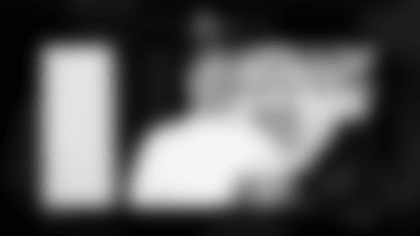Dave Levy, the Tampa Bay Buccaneers' long-time video director and a legend in the industry, is headed to the Pro Football Hall of Fame. His nearly four-decade journey to Canton started with a broken toboggan.
On Wednesday, the Pro Football Hall of Fame announced that Levy was a recipient of its Award of Excellence as part of a new program that recognizes significant contributors to the game of football in five categories – film/video directors, assistant coaches, athletic trainers, equipment managers and public relations personnel. Recipients of the award are honored with a plaque in a special wing of the Hall of Fame in Canton, Ohio.
Rondé Barber, the Bucs legendary cornerback who was just inducted into the Pro Football Hall of Fame last summer, is thrilled to welcome his good friend and colleague into Canton.
"I didn't know that this was a thing, but the fact that it is awesome," said Barber. "And there's no more deserving guy for the honor. I remember when [current Buccaneers Video Director] Brett [Greene] came here and was taking over for Dave. I think the level of reverence that he had for Dave kind of speaks to what we're all recognizing in him – there's a Hall of Fame for video directors and Dave is part of that. I'm not in that industry so I couldn't tell you exactly what it was he did that was cutting edge or different or better but I know he was known around the league as an innovator. And the way he treated us and everybody at One Buc I can't believe there would be a better choice for the award."
In just its second year of selecting candidates for the Award of Excellence, a six-person committee of NFL video directors chose three luminaries in their profession for the honor in 2024 – Levy, Bob "Mac" McCartney of the Pittsburgh Steelers and Tom Atcheson of the Atlanta Falcons. Pat Brazil, who worked in Levy's department with the Bucs for 15 seasons before being hired as the Kansas City Chiefs' video director in 2006, is one of the six people on that committee. It was likely only a matter of time until Levy was chosen for the award, but his inclusion in just the second Hall of Fame class of video professionals was meaningful.
"He was humbled by the fact that he got in during the first two years of this," said Brazil. "I said to him, 'Dave, there's a lot of Hall of Famers, but if you look at the players who are in, there are definitely some who were obviously first-ballot guys.' It was a clear consensus that, for our profession, Dave was definitely one of those guys."
Levy no longer works in the NFL – he spent two seasons with teams in alternate leagues like the XFL and dabbles in real estate photography – but he likes to drop in on the NFL Scouting Combine to catch up with his friends in the league. In this case, they caught him by surprise when they announced the award winners.
"There's so many other people it could have been besides me," he said. "You always have that hope that one day it might happen, but they surprised me."
That Levy and McCartney are being honored in the same class is fitting because it was McCartney – coincidentally the father of current Buccaneers Director of Player Personnel Rob McCartney – who drew Levy into the NFL video world at a very young age in the early 1980s. McCartney, an avid outdoorsman, needed a part for his broken toboggan and was having trouble locating one until he came into the Levy's sporting goods store in the Pittsburgh area and met Dave Levy Sr.
"He couldn't find the part he needed anywhere, and he came in our store and my dad found him the part," said Levy. "And then he became a regular customer, and then he became a good friend."
McCartney and the elder Levy would go fishing together, and they were part of a fishing and hunting club that met every Wednesday night for dinner. Every month or two, McCartney would bring in Steelers highlights to show the club, and the younger Levy got involved in the set-up and breakdown of the screen, projector and film. He was 11 at the time.
A year later, McCartney brought the 12-year-old Levy in to help in the Steelers' film department, first through such tasks as running tape, carrying tripods and sweeping floors during games and in training camp. At 13, Levy began doing actual video work, making five dollars an hour. After roughly eight years of working with the Steelers, Levy landed the head job in Tampa under coach Ray Perkins in 1988. He was still just 20 years old, and is believed to be the youngest NFL video director ever.
"I remember [former Bucs Public Relations Director] Rick Odioso was the first person on the staff to call me, and he said, 'You're how old?'" recalled Levy with a laugh.
Ray Perkins son, Mike, had just spent one season as a video assistant, and the Bucs were looking to hire a new director for the department in 1988, preferably someone who could keep the team in step with advancing technology, particularly in the switch from film to video. Ray initially wanted to give the job to Mike, who would eventually go on to a long career in football technology with the Jaguars, but Mike didn't think he was ready. Instead, he interviewed four candidates, including Levy, who was recommended by others in the industry. Levy was actually a month younger than Perkins, but he was definitely ready.
Chris Bryan, who joined Levy's staff during the 2000 season and worked with him for 17 years, says it didn't take long for people to realize how proficient he was at all aspects of the job.
"Dave didn't have a college degree or anything like that but he was extremely knowledgeable," said Bryan. "He grew up in the business. Everybody around the league looked to Dave, including coaches. Even coaches who weren't on the Bucs' staff called Dave about the technology and what he thought was the right way to go. It was really neat to learn how well-respected he was in that regard. For somebody else who also didn't go to college, it was great to see this guy who knew his craft and knew it very well, and people respected his opinion. People called him because he was real and his opinion really mattered throughout the league."
Of course, the transition away from film was only the beginning of the advancements the NFL video profession would see over the 29 seasons Levy spent as the Buccaneers' director, a tenure that came to an end after the 2016 season. The NFL would eventually move to digital, and then to high-definition.
"He was actually a big part of that change because he was a part of the video directors committee at that time," said Brazil. "They were on the forefront of digging into that technology, finding the next format that would allow us to move forward. Technology changes, and it changes quick. He was very instrumental in the league moving from analog to digital, and then to high-definition in 2013."
Added Bryan: "I was 26 years old and I was saying, 'Everyone looks up this guy.' It was amazing. The NFL is a big, big, big league and Dave was one of the guys. Everywhere we want, Dave was seen as an innovator and someone who was very well respected, and his knowledge was respected on all these things. It was an honor to work with him."
Levy is also pleased to be honored in the same class as Atcheson, who he calls his second biggest professional influence after McCartney. Atcheson was running the video production at the Combine, a complicated and time-consuming operation, and he took Levy under his wing. When Atcheson retired in 1997, he made Levy his hand-picked replacement. Levy, still not yet 30 years old, took that prestigious position and ran with it.
"Part of the reason I'm going in [the Hall] is I ran the video operations at the Combine for 20 years," said Levy. "He ran it before me and when I started going to the Combine I started learning from him how to run it. When he finally retired in '97, he said, 'Okay, now you're in charge of the Combine.'"
It was Perkins who was chosen to announce Levy's honor at a meeting of the Combine video crew earlier this month. "He literally made the Combine what it is today," said Perkins during his speech.
"I didn't know just how much respected Dave was in the industry until I went to my first Combine in 2007," said Bryan. "I learned that Dave Levy was 'the man' in NFL circles in the video world. It was really neat to find that out. We would go to a road game and we'd run into the G.M. for the other team and he would come and talk to Dave. We're trying to set up cameras and stuff and they're talking about going from Beta tape to digital, or rules changing with the Combine and the interviews there. People knew that he was one of the leaders in the industry and they all sought his knowledge."
Brazil, who left the Bucs to join Herm Edwards staff in Kansas City, says he has based his approach to the job largely on what he learned from Levy.
"Obviously things change, technology changes over time, but the structure of it and how we go about our jobs day to day, and the professionalism we show, that all comes from Dave," said Brazil. "There's a job to do, get the job done in a timely fashion. I learned how to prioritize things with coaches on a daily basis. Really, everything comes from him. He taught me so much that I replicated it as much as I could when I came here. Everyone puts their own tweaks on things, but the base and the foundation of how I run my department definitely started with what he showed me in Tampa."
According to employees and players who crossed paths with Levy during his Buccaneers tenure, he didn't just run a department. He fostered a community. Barber was one of many players who would spend time in the video department at the Buccaneers' original One Buccaneer Place facility. The rectangular room, 10 feet wide and 22 feet deep, was affectionately known as 'The Closet' and was just a few feet down the hall from the locker room. Others, such as Mike Alstott and Joe Jurevicius gravitated toward 'The Closet,' too.
"It was where we knew we could find each other, to be honest with you," said Barber. "Dave just embraced the fact that little part of it was helping us stay a tight-knit team. It was definitely a place where we could find comfort in all of our differences, because none of us were alike. Dave was a life-long video guy in the NFL; he'd been around it basically for his whole existence. Then Chris and Wes [Bryan] were St. Pete kids who were grinding away, and then there were players in there. It was an awesome environment that he cultivated. He allowed it to happen."
Levy had three assistants at the time and with just a few players stopping by the room got crowded quick. But it was never uncomfortable.
"The players really respected Dave," said Bryan. "Every single one of them. They all loved him and respected him. They were always in his office. The video room at old One Buc was a really neat community of people who were in there all the time. He allowed us to be friends with the players, and I found out from other guys around the league that that just doesn't happen everywhere. Guys didn't have relationships with players like we did. Some of those guys I'm friends with to this day."
It didn't take Barber long to strike up a friendship with Levy after arriving as a third-round draft pick in 1997. Barber had trouble finding playing time as a rookie, which was obviously an emotional challenge, but he found respite in Levy's community.
"I didn't talk to anybody when I first got here because I was just trying to find my way," he said. "But once I wasn't playing in my rookie year, I needed some place to go and be myself and buy time to steady myself. I don't know why they let me do that in there, but Dave invited me in right away. It was easy and natural. I wasn't in his way, but he also just enjoyed having guys in there.
"All you had to talk to anybody else in the league. It was one of the good things of being friends with Dave and it's actually paid dividends throughout the years for me, because everywhere I go I know a video guy through Dave. When you talked to anybody else in the business about Dave you could tell the respect was there. I could tell right from the get-go when I got there how respected he was."
From running film as a 12-year-old to running his own department for three decades in Tampa, Levy witnessed the NFL video profession go through profound changes. He was in fact, a critical instrument in that change. Technological advancements made some tasks easier and less time-consuming – in the days of Beta tape, Levy and his staff would go back to the office after games and not get home until Tuesday afternoon – but it also created new kinds of work. Levy always tried to strike a work-home balance, and according to Bryan he fostered a family atmosphere at the office, too.
"It was a very fulfilling career," said Levy. "Of course the hours, as you know, are very long at times. It takes a lot from your family but it also gives a lot to your family. You make the best of it in the offseason when you have a little more time, but it let me provide for my kids and get them through school. It was fulfilling in that way but it was also a really fun job, a fun thing to do. My best friends in life are video guys. I've got two real good friends from high school but beyond them my best friends are the video guys."
Asked to pinpoint the most memorable moment of his Buccaneers tenure, Levy points to Barber's game-clinching 92-yard pick-six in the 2002 NFC Championship Game in Philadelphia. Levy was in an open-air video booth at the 50-yard line and he vividly remembers Veterans Stadium going from a roar to dead silence. "I had chills," said Levy. "I might have even cried."
Asked about the pinnacle of his own career, Levy didn't have to think long. The answer was obvious: This. Having a plaque dedicated to him going into the Pro Football Hall of Fame and being recognized as one of the most accomplished video professionals in league history.
"I think it's incredible," said Brazil. "We are all proud of what we do, but I think it's incredible that they started doing this. I'm very happy for Dave and he definitely deserves to be in the Hall of Fame.























